Impacts and Prediction of Land Use/Cover Change on Runoff in the Jinghe River Basin, China
Abstract
1. Introduction
2. Methods and Materials
2.1. Study Area
2.2. Data Source
2.3. SWAT Model
2.3.1. Sensitivity Analysis
2.3.2. Calibration and Validation
2.4. Land Use Dynamic Index
2.5. PLUS Model
2.5.1. Distribution Probability of Land Use Types
2.5.2. Multiple Scenario Settings
2.5.3. Neighborhood Weights
2.5.4. Conversion Cost Matrix
2.5.5. Model Accuracy Verification
3. Result Analysis
3.1. Calibration and Validation of the SWAT Model
3.2. Features of Land Use/Cover Change
3.3. Impact of Land Use/Cover Change on Runoff
3.4. Future Land Use/Cover Scenarios and Runoff Projections
4. Discussion
5. Conclusion
Author Contributions
Funding
Institutional Review Board Statement
Informed Consent Statement
Data Availability Statement
Acknowledgments
Conflicts of Interest
Appendix A. Summary of Parameter Sensitivity for the SWAT Model in the Jing River Basin
| Rank | Parameter | Description | Optimal Value | Parameter Range |
| 1 | V__CH_K2.rte | Effective hydraulic conductivity in main channel alluvium | 0.186 | 0~150 |
| 2 | V__CH_N2.rte | Manning’s n value for main channel | 0.214 | 0~0.3 |
| 3 | R__SOL_AWC(..).sol | Soil available water storage capacity | 0.415 | −0.2~1 |
| 4 | V__CN2.mgt | SCS runoff curve number | 55.418 | 35~98 |
| 5 | R__HRU_SLP.hru | Average slope steepness | 0.288 | 0~0.6 |
| 6 | V__TLAPS.sub | Temperature lapse rate | −7.188 | −10~10 |
| 7 | V__GW_DELAY.gw | Groundwater delay time | 390.114 | 0~500 |
| 8 | V__EPCO.hru | Plant uptake compensation factor | 0.891 | 0~1 |
| 9 | R__SOL_ALB(..).sol | Surface reflectance | −0.015 | 0.25~0.25 |
| 10 | V__BIOMIX.mgt | Biological mixing efficiency | 0.663 | 0~1 |
| 11 | R__SOL_Z(..).sol | Soil depth | 0.385 | −0.5~0.5 |
| 12 | V__REVAPMN.gw | Shallow groundwater re-evaporation coefficient | 64.682 | 0~500 |
| 13 | R__GW_REVAP.gw | Groundwater revap coefficient | 0.088 | 0.02~0.2 |
| 14 | V__SOL_BD(..).sol | Soil bulk density | 0.980 | 0.9~2.5 |
| 15 | R__CANMX.hru | Maximum canopy storage | 22.162 | 0~100 |
| 16 | R__SURLAG.bsn | Surface runoff lag coefficient | 15.095 | 0.05~24 |
References
- Tian, J.; Guo, L.S.; Liu, D.D.; Chen, Q.H.; Wang, Q.; Yin, J.B.; Wu, X.S.; He, S.K. Impacts of climate and land use/cover changes on runoff in the Hanjiang River basin. Geogr. J. 2020, 75, 2307–2318. [Google Scholar] [CrossRef]
- Li, Z.; Liu, W.Z.; Zhang, X.C.; Zheng, F.L. Impacts of land use change and climate variability on hydrology in an agricultural catchment on the Loess Plateau of China. J. Hydrol. 2009, 377, 35–42. [Google Scholar] [CrossRef]
- Ding, Y.; Feng, H.; Zou, B. Remote Sensing-Based Estimation on Hydrological Response to Land Use and Cover Change. Forests 2022, 13, 1749. [Google Scholar] [CrossRef]
- Aragaw, H.M.; Goel, M.K.; Mishra, S.K. Hydrological responses to human-induced land use/land cover changes in the Gidabo River basin, Ethiopia. Hydrol. Sci. J. 2021, 66, 640–655. [Google Scholar] [CrossRef]
- Ding, N.; Li, Y.B.; Tao, F.L. Effects of climate change and land use change on runoff, sediment, nitrogen and phosphorus losses in the Haihe River Basin. J. Nat. Resour. 2024, 39, 1720–1734. [Google Scholar] [CrossRef]
- Bosch, J.M.; Hewlett, J.D. A review of catchment experiments to determine the effect of vegetation changes on water yield and evapotranspiration. J. Hydrol. 1982, 55, 3–23. [Google Scholar] [CrossRef]
- Zhang, L.N.; Li, X.B. Assessing Hydrological Effects of Human Activities by Hydrological Characteristic Parameters: A Case Study in the Yunzhou Reservoir Basin. Resour. Sci. 2004, 26, 62–67. [Google Scholar] [CrossRef]
- Liu, X.Y.; Zhang, H.L.; Luo, Z.Y.; Zhang, J.Q.; An, N. Response of Runoff and Sediment Yields to Land Use Change in Fu River Watershed Based on SWAT Model. Res. Soil Water Conserv. 2024, 31, 79–89, 100. [Google Scholar] [CrossRef]
- Liu, B.; Yang, J.; Sha, J.X.; Luo, Y.; Zhao, X.; Liu, R.T. Analysis of runoff according to land-use change in the upper Hutuo River basin. Water 2023, 15, 1138. [Google Scholar] [CrossRef]
- Wang, H.; Yuan, W.; Chen, W.; Hong, F.T.; Bai, X.Y.; Guo, W.X. Response of hydrological regimes to land use change: A case study of the Han River Basin. J. Water Clim. Change 2023, 14, 4708–4728. [Google Scholar] [CrossRef]
- Yuan, S.J.; Gao, X.R.; Huang, K.J.; Jiang, S.; He, G.H.; Zhao, X.N. Quantitative simulation of hydrological elements based on RHESSys model in Yanhe River basin. S.-N. Water Transf. Water Sci. Technol. 2023, 21, 116–126. [Google Scholar] [CrossRef]
- Chai, Q.; Zhang, S.; Tian, Q.; Yang, C.; Guo, L. Daily runoff prediction based on FA-LSTM model. Water 2024, 16, 2216. [Google Scholar] [CrossRef]
- Zhou, J.C.; Huang, J.C.; Yang, L.L.; Gu, W.Y. Runoff simulation in the Ganjiang river basin based on the Xin’anjiang model coupled with the LSTM. Water Resour. Power 2024, 42, 12–15. [Google Scholar] [CrossRef]
- Tiwari, A.D.; Mukhopadhyay, P.; Mishra, V. Influence of bias correction of meteorological and streamflow forecast on hydrological prediction in India. J. Hydrometeorol. 2022, 23, 1171–1192. [Google Scholar] [CrossRef]
- Devia, G.K.; Ganasri, B.P.; Dwarakish, G.S. A review on hydrological models. Aquat. Procedia 2015, 4, 1001–1007. [Google Scholar] [CrossRef]
- Dogan, F.N.; Karpuzcu, M.E. Effect of land use change on hydrology of forested watersheds. Ecohydrology 2022, 15, e2367. [Google Scholar] [CrossRef]
- Khand, K.; Senay, G.B. Runoff response to directional land cover change across reference basins in the conterminous united states. Adv. Water Resour. 2021, 153, 103940. [Google Scholar] [CrossRef]
- Liu, W.; Wu, J.; Xu, F.; Mu, D.W.; Zhang, P.B. Modeling the effects of land use/land cover changes on river runoff using SWAT models: A case study of the Danjiang River source area, China. Environ. Res. 2024, 242, 117810. [Google Scholar] [CrossRef]
- Mayou, L.A.; Alamdari, N.; Ahmadisharaf, E.; Kamali, M. Impacts of future climate and land use/land cover change on urban runoff using fine-scale hydrologic modeling. J. Environ. Manag. 2024, 362, 121284. [Google Scholar] [CrossRef]
- Yang, Z.Y.; Niu, J.Z.; Fan, D.X.; Zhang, Z.P.; Du, Z.; Zhao, C.G. Response and Prediction of Runoff to Land Use Change in Kuye River Basin Based on SWAT and PLUS Models. J. Soil Water Conserv. 2024, 38, 289–299. [Google Scholar] [CrossRef]
- Chen, X.; Han, R.G.; Feng, P.; Wang, Y.J. Combined effects of predicted climate and land use changes on future hydrological droughts in the Luanhe River basin, China. Nat. Hazards 2022, 110, 1305–1337. [Google Scholar] [CrossRef]
- Mo, C.; Bao, M.; Lai, S.; Deng, J.; Tang, P.; Xing, Z.; Tang, G.; Li, L. Impact of future climate and land use changes on runoff in a typical Karst basin, southwest China. Water 2023, 15, 2240. [Google Scholar] [CrossRef]
- Park, J.Y.; Park, M.J.; Joh, H.K.; Shin, H.J.; Kwon, H.J.; Srinivasan, R.; Kim, S.J. Assessment of MIROC3.2 hires climate and CLUE-S land use change impacts on watershed hydrology using SWAT. Trans. ASABE 2011, 54, 1713–1724. [Google Scholar] [CrossRef]
- Du, Z.; Niu, J.Z.; Fan, D.X.; Zhang, Z.P.; Yang, Z.Y. Simulation and Driving Force Analysis of Land Use Change in the Sandy and Coarse Region of the Middle Reaches of the Yellow River Based on PLUS Model. Res. Soil Water Conserv. 2024, 31, 309–318. [Google Scholar] [CrossRef]
- Liang, X.; Guan, Q.F.; Clarke, K.C.; Liu, S.S.; Wang, B.Y.; Yao, Y. Understanding the drivers of sustainable land expansion using a patch-generating land use simulation (PLUS) model: A case study in Wuhan, China. Comput. Environ. Urban Syst. 2021, 85, 101569. [Google Scholar] [CrossRef]
- Wang, J.; Zhang, J.P.; Xiong, N.N.; Liang, B.Y.; Wang, Z.; Cressey, E.L. Spatial and temporal variation, simulation and prediction of land use in ecological conservation area of western Beijing. Remote Sens. 2022, 14, 1452. [Google Scholar] [CrossRef]
- Mutale, B.; Qiang, F. Modeling future land use and land cover under different scenarios using patch-generating land use simulation model. A case study of Ndola district. Front. Environ. Sci. 2024, 12, 1362666. [Google Scholar] [CrossRef]
- Penny, J.; Ordens, C.M.; Barnett, S.; Djordjević, S.; Chen, A.S. Small-scale land use change modelling using transient groundwater levels and salinities as driving factors—An example from a sub-catchment of Australia’s Murray-darling basin. Agric. Water Manag. 2023, 278, 108174. [Google Scholar] [CrossRef]
- Ersoy Tonyaloğlu, E. Future land use/land cover and its impacts on ecosystem services: Case of Aydın, Turkey. Int. J. Environ. Sci. Technol. 2025, 22, 4601–4617. [Google Scholar] [CrossRef]
- Huang, C.; Zhou, Y.; Wu, T.; Zhang, M.; Qiu, Y. A cellular automata model coupled with partitioning CNN-LSTM and PLUS models for urban land change simulation. J. Environ. Manag. 2024, 351, 119828. [Google Scholar] [CrossRef]
- Peng, B.; Yang, J.; Li, Y.; Zhang, S. Land-use optimization based on ecological security pattern—A case study of Baicheng, Northeast China. Remote Sens. 2023, 15, 5671. [Google Scholar] [CrossRef]
- Chen, Y.; Zhang, L.; Yan, M.; Wu, Y.; Dong, Y.; Shao, W.; Zhang, Q. Spatiotemporal evolution and future simulation of land use/land cover in the Turpan-Hami basin, China. J. Arid Land 2024, 16, 1303–1326. [Google Scholar] [CrossRef]
- Liu, J.; Liu, B.; Wu, L.; Miao, H.; Liu, J.; Jiang, K.; Ding, H.; Gao, W.; Liu, T. Prediction of land use for the next 30 years using the PLUS model’s multi-scenario simulation in Guizhou province, China. Sci. Rep. 2024, 14, 13143. [Google Scholar] [CrossRef] [PubMed]
- Ma, L.G.; Liu, J.W.; Pang, X.T.; Jing, H.W. Analysis of Hydrological Elements and Runoff Prediction in Tao′er River Basin under Land Use and Climate Change. J. Soil Water Conserv. 2024, volume, 1–11. [Google Scholar] [CrossRef]
- Huang, B.B.; Hao, C.Y.; Li, R.N.; Zheng, H. Research Progress on the Quantitative Methods of Calculating Contribution Rates of Climate Change and Human Activities to Surface Runoff Changes. J. Nat. Resour. 2018, 33, 899–910. [Google Scholar] [CrossRef]
- Liu, H.B.; Jian, H.R. Impacts of Climate and Underlying Surface Factors on Runoff Variation in Jinghe River Basin. Yellow River 2021, 43, 22–28. [Google Scholar] [CrossRef]
- Liu, Z.X.; Chen, X.; Guan, X.X.; Shu, Z.K.; Yang, X.T.; Wang, G.Q. Attribution of Runoff Change in the Taohe River Basin Under a Changing Environment. Res. Soil Water Conserv. 2020, 27, 87–92+100. [Google Scholar] [CrossRef]
- Liu, F.; Xiong, W.; Wang, Y.H.; Yu, P.T.; Xu, L.H. Relationship between landscape pattern and runoff based on LUCC in Jinghe river watershed. J. Arid Land Resour. Environ. 2019, 33, 137–142. [Google Scholar] [CrossRef]
- Liu, Y.; Guan, Z.L.; Huang, T.T.; Wang, C.C.; Guan, R.H.; Ma, X.Y. Combined effects of land usecover change and climate change on runoff in the Jinghe river basin, China. Atmosphere 2023, 14, 1237. [Google Scholar] [CrossRef]
- Wang, H.; Liu, G.H.; Li, Z.H.; Wang, P.T.; Wang, Z.Z. Assessing the driving forces in vegetation dynamics using net primary productivity as the indicator: A case study in Jinghe river basin in the loess plateau. Forests 2018, 9, 374. [Google Scholar] [CrossRef]
- Tang, C.; Li, J.; Zhou, Z.; Zeng, L.; Zhang, C.; Ran, H. How to optimize ecosystem services based on a bayesian model: A case study of Jinghe River basin. Sustainability 2019, 11, 4149. [Google Scholar] [CrossRef]
- Hu, F.; Zhang, Y.; Guo, Y.; Zhang, P.P.; Lv, S.; Zhang, C.C. Spatial and temporal changes in land use and habitat quality in the Weihe River Basin based on the PLUS and InVEST models and predictions. Arid Land Geogr. 2022, 45, 1125–1136. [Google Scholar] [CrossRef]
- Yu, G.X.; Hai, X.Q.; Yang, X. Spatio-temporal Evolution and Prediction of Carbon Storage in Jinghe Basin Ecosystem. Adm. Tech. Environ. Monit. 2023, 35, 33–38. [Google Scholar] [CrossRef]
- Easton, Z.M.; Fuka, D.R.; Walter, M.T.; Cowan, D.M.; Schneiderman, E.M.; Steenhuis, T.S. Re-conceptualizing the soil and water assessment tool (SWAT) model to predict runoff from variable source areas. J. Hydrol. 2008, 348, 279–291. [Google Scholar] [CrossRef]
- Narsimlu, B.; Gosain, A.K.; Chahar, B.R. Assessment of future climate change impacts on water resources of upper Sind river basin, India using SWAT model. Water Resour. Manag. 2013, 27, 3647–3662. [Google Scholar] [CrossRef]
- Yang, J.; Reichert, P.; Abbaspour, K.C.; Xia, J.; Yang, H. Comparing uncertainty analysis techniques for a SWAT application to the Chaohe basin in China. J. Hydrol. Amst. 2008, 358, 1–23. [Google Scholar] [CrossRef]
- Ostad-Ali-Askari, K. Arrangement of watershed from overflowing lookout applying the SWAT prototypical and SUFI-2 (case study: Kasiliyan watershed, Mazandaran province, Iran). Appl. Water Sci. 2022, 12, 196. [Google Scholar] [CrossRef]
- Boughton, W.C. A review of the USDA SCS curve number method. Soil Res. 1989, 27, 511–523. [Google Scholar] [CrossRef]
- Moriasi, D.N.; Arnold, J.G.; van Liew, M.W.; Bingner, R.L.; Harmel, R.D.; Veith, T.L. Model evaluation guidelines for systematic quantification of accuracy in watershed simulations. Trans. ASABE 2007, 50, 885–900. [Google Scholar] [CrossRef]
- Han, H.R.; Yang, C.F.; Song, J.P. The Spatial-Temporal Characteristic of Land Use Change in Beijing and Its Driving Mechanism. Econ. Geogr. 2015, 35, 148–154+197. [Google Scholar] [CrossRef]
- Li, Y.; Yao, S.; Jiang, H.Z.; Wang, H.R.; Ran, Q.C.; Gao, X.Y.; Ding, X.Y.; Ge, D.D. Spatial-temporal evolution and prediction of carbon storage: An integrated framework based on the MOP–PLUS–InVEST model and an applied case study in Hangzhou, East China. Land 2022, 11, 2213. [Google Scholar] [CrossRef]
- Zhang, X.B.; Guo, L.K.; Wang, Z.B. Habitat Quality Evaluation and Simulation Prediction in Hefei City Based on InVEST-PLUS Coupled Modeling. Environ. Sci. 2024, volume, 1–16. [Google Scholar] [CrossRef]
- Xie, X.D.; Lin, X.S.; Wang, Y.; Tu, R.Y.; Zhang, J.X. Multi-scenario Simulation of Land Use in Nanchuan District of Chongqing Based on PLUS Model. J. Changjiang River Sci. Res. Inst. 2023, 40, 86–92+113. [Google Scholar] [CrossRef]
- Yuan, X. Simulation of Land Use Change Scenarios and Study on Landscape Ecological Risks in Wuhan City Based on PLUS Mode. Master’s Thesis, East China University of Technology, Fuzhou, China, 2023. [Google Scholar] [CrossRef]
- Wang, W.C. Research on Simulation and Prediction of Urban and Rural Green Space Based on PLUS Model: A Case Study of Jinan City. Master’s Thesis, Shandong Jianzhu University, Jinan, China, 2023. [Google Scholar] [CrossRef]
- Ji, L.; Wang, Q.J.; Zhu, G.C. Carbon Storage Assessment and Land Use Multi-scenario Simulation in Jinzhou City Based on PLUS and InVEST Models. J. Fujian Norm. Univ. (Nat. Sci. Ed.) 2024, 40, 44–56. [Google Scholar] [CrossRef]
- Dong, L.J.; Dong, X.H.; Wei, C.; Yu, D.; Bo, H.J.; Guo, J. Research on the Impact of LUCC on Hydrological Extremum in Yalong River Basin. China Rural Water Hydropower 2020, 4, 13–21. [Google Scholar] [CrossRef]
- Xu, C.; Jiang, Y.A.; Su, Z.H.; Liu, Y.J.; Lyu, J.Y. Assessing the impacts of grain-for-green programme on ecosystem services in Jinghe river basin, China. Ecol. Indic. 2022, 137, 108757. [Google Scholar] [CrossRef]
- Zhen, L.; Xie, G.D.; Yang, L.; Cheng, S.K.; Guo, G.M. Land-Use Change Dynamics Driving Forces and Policy Implications in Jinghe Watershed of Western China. Resour. Sci. 2005, 27, 33–37. [Google Scholar] [CrossRef]
- Wang, Y.P.; Jiang, R.G.; Xie, J.C.; Zhao, Y.; Lv, X.X. Research on the monthly runoff distributed simulation and its application in Jinghe River Basin based on SWAT model. J. Xi’an Univ. Technol. 2020, 36, 135–144, 158. [Google Scholar] [CrossRef]
- Hou, Y.K.; Huang, X.; Chen, H.; Xu, C.Y. The application of SWAT to simulate the runoff in the Xiangjiang basin and the parameter sensitivity analysis. J. Water Resour. Res. 2014, 3, 85–94. [Google Scholar] [CrossRef]
- Lin, B.Q.; Chen, Y.; Chen, X.W. A Study on Regional Difference of Hydrological Parameters of SWAT Model. J. Nat. Resour. 2013, 28, 1988–1999. [Google Scholar] [CrossRef]
- Williams, J.R.; LaSeur, W.V. Water yield model using SCS curve numbers. J. Hydraul. Div. 1976, 102, 1241–1253. [Google Scholar] [CrossRef]
- Yang, T.; Yan, X.J.; Zhao, H.S.; Wang, P.; Zhu, T.; Cai, H.J.; Zuo, X.G.; Xi, R.G.; Zhang, Y.L.; Wang, L.S.; et al. Land use changes of Weihe River Basin and it’s influence on the ecological spatial pattern. Geol. China 2023, 50, 1460–1470. [Google Scholar] [CrossRef]
- Shi, P.; Li, P.; Li, Z.B.; Sun, J.M.; Wang, D.J.; Min, Z.Q. Effects of grass vegetation coverage and position on runoff and sediment yields on the slope of loess plateau, China. Agric. Water Manag. 2022, 259, 107231. [Google Scholar] [CrossRef]
- Shrestha, S.; Cui, S.H.; Xu, L.L.; Wang, L.H.; Manandhar, B.; Ding, S.P. Impact of land use change due to urbanisation on surface runoff using GIS-based SCS–CN method: A case study of Xiamen city, China. Land 2021, 10, 839. [Google Scholar] [CrossRef]
- Allali, H.; Elmeddahi, Y.; Badni, N.; EI-nesr, M. Assessment of the hydrological responces to land use changes in wadi Ouahrane watershed, Algeria. Russ. Meteorol. Hydrol. 2023, 48, 1084–1092. [Google Scholar] [CrossRef]
- Zhang, L.M.; Meng, X.Y.; Wang, H.; Yang, M.X. Simulated Runoff and Sediment Yield Responses to Land-Use Change Using the SWAT Model in Northeast China. Water 2019, 11, 915. [Google Scholar] [CrossRef]
- Wu, K.J.; Zhu, Y.J.; Zhou, B. Analysis on Karst Water System of the Eastern Foot of Liupan Mountain. Yellow River 2011, 33, 78–79+82. [Google Scholar] [CrossRef]
- Li, X.Y.; Wen, J.; Xie, Y.; Chen, Y.L.; Chen, Y.X.; Ge, X.Y. Research on Runoff Simulation over the Source Area of the Yellow River based on the Multiple Precipitation Products. Plateau Meteorol. 2024, 43, 570–582. [Google Scholar] [CrossRef]
- Wang, J.; Chen, Y.D.; Liang, F.J.; Ge, H.; Liu, M.; Chen, J.D.; Wang, L.R. Hydrological simulation based on CMADS dataset and basin similarity in ungauged areas: A case study of Yuanjiang-Red River basin. S.-N. Water Transf. Water Sci. Technol. 2024, 22, 534–544. [Google Scholar] [CrossRef]
- Yang, K.J.; Lv, C.H. Reviews on Application and Uncertainty of SWAT Model. J. Soil Water Conserv. 2018, 32, 17–24+31. [Google Scholar] [CrossRef]
- Li, R.Z.; Wu, L.; Du, B.L.; Guo, Z.J.; Wang, Y.; Xu, L.J. Impact of DEM and land cover resolution on the simulation of runoff and sediment in SWAT Model: A case study of Jinghe River Basin. J. Water Resour. Water Eng. 2023, 34, 70–79. [Google Scholar] [CrossRef]
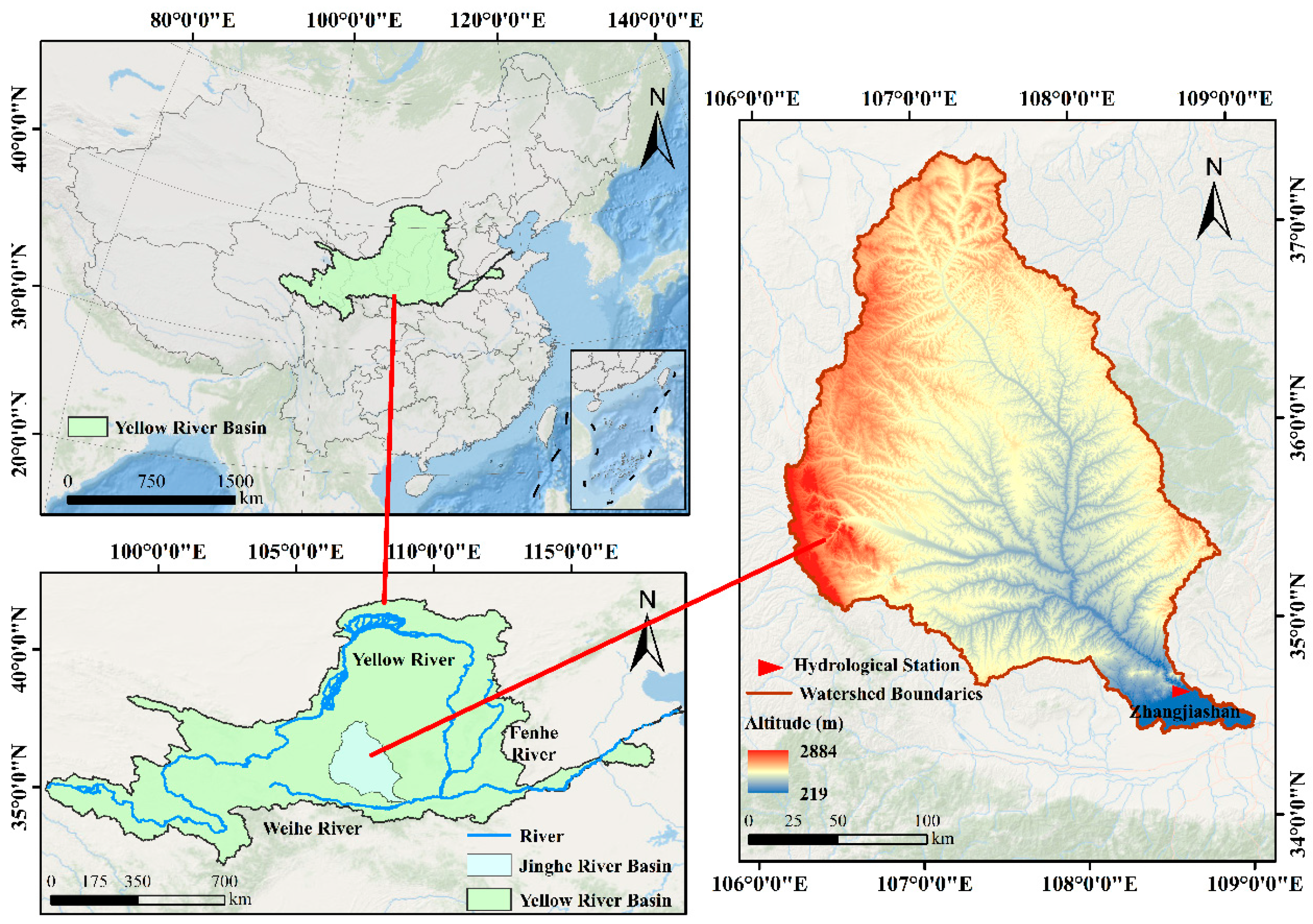
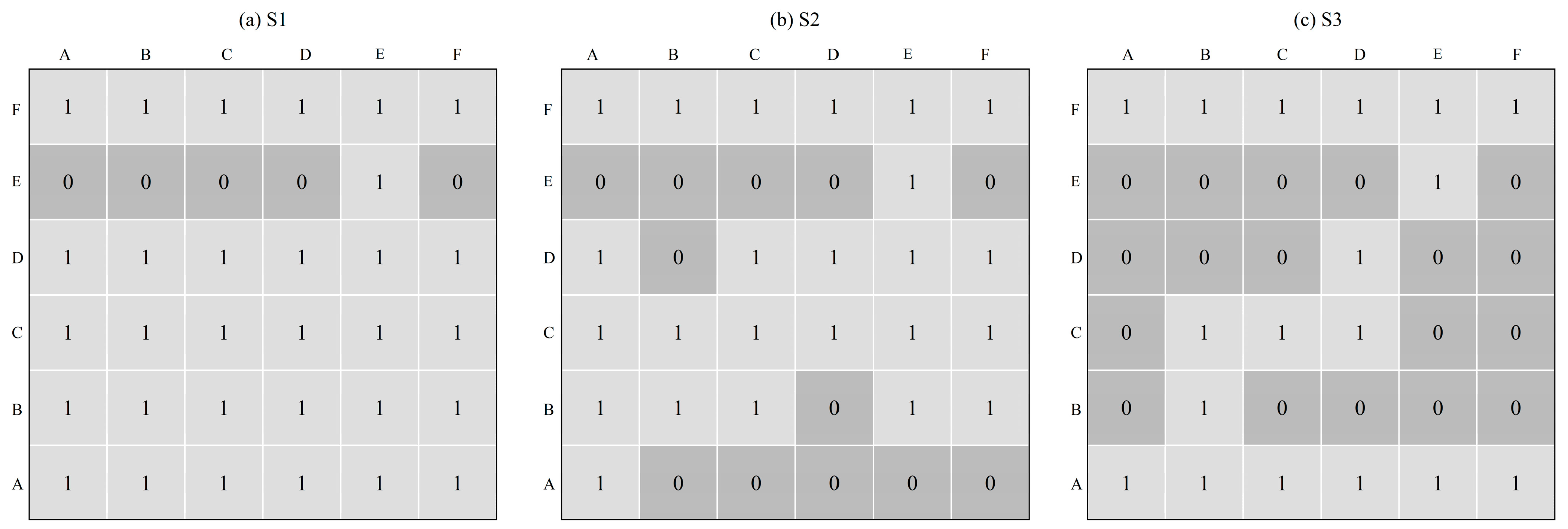

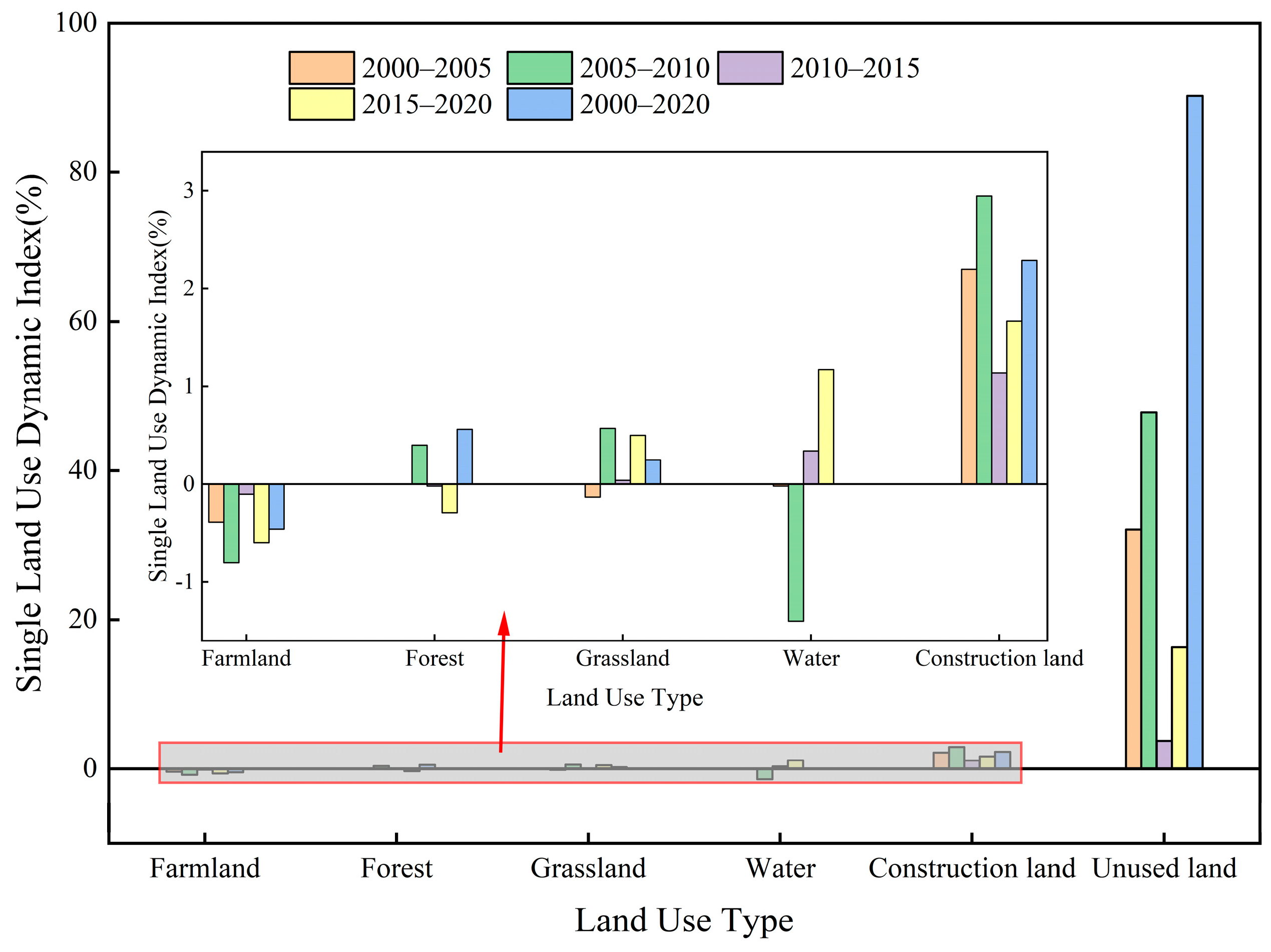
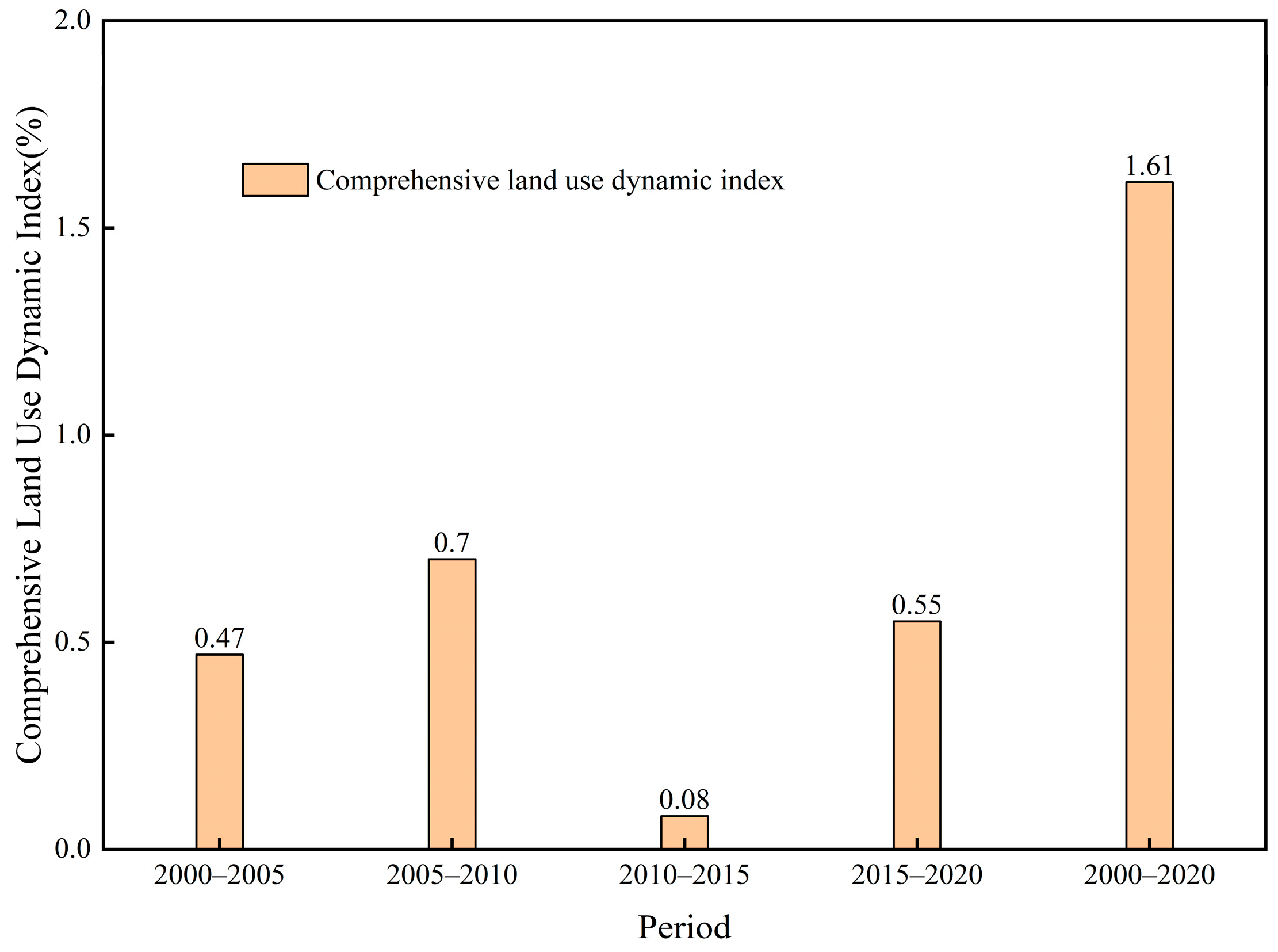
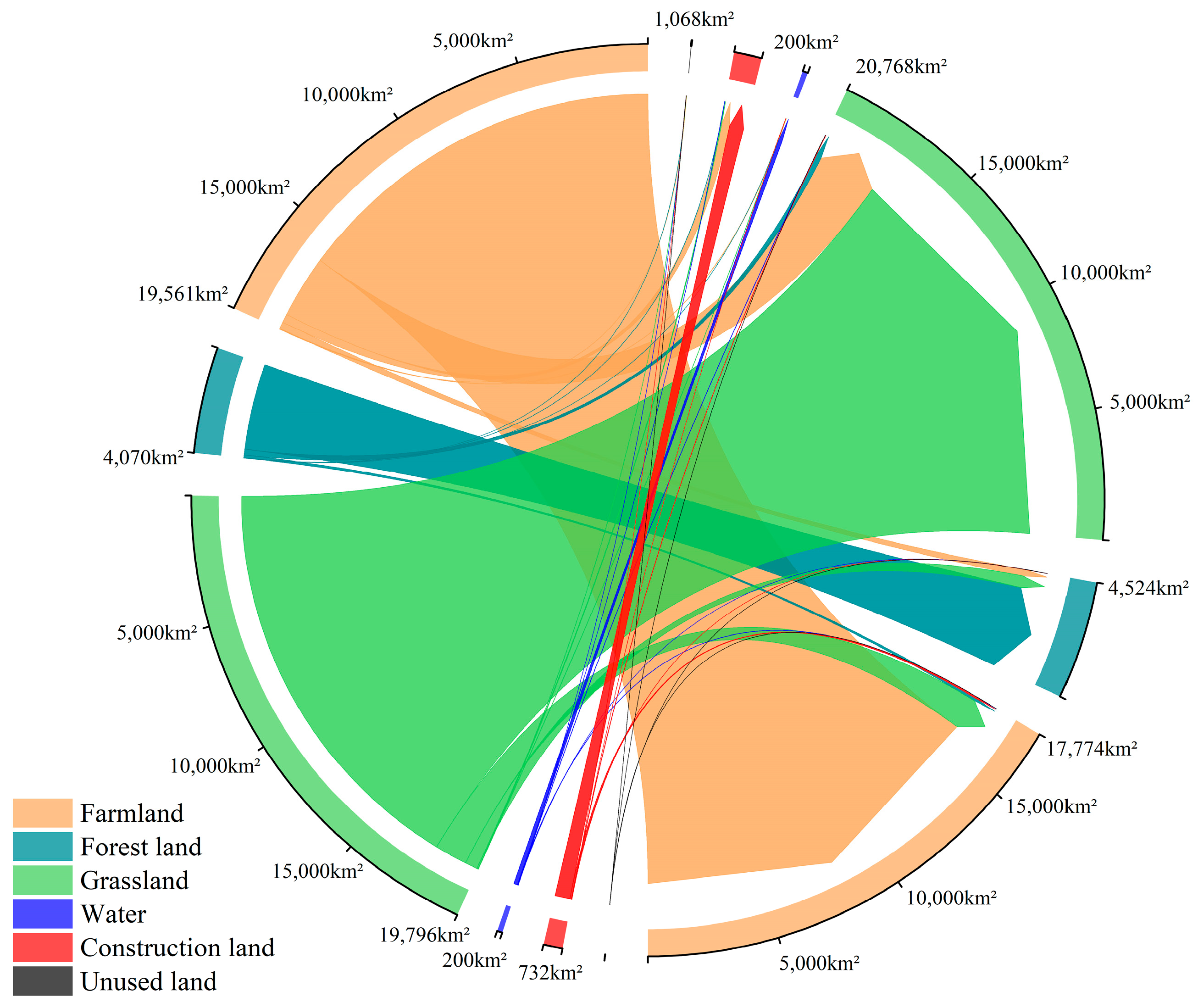

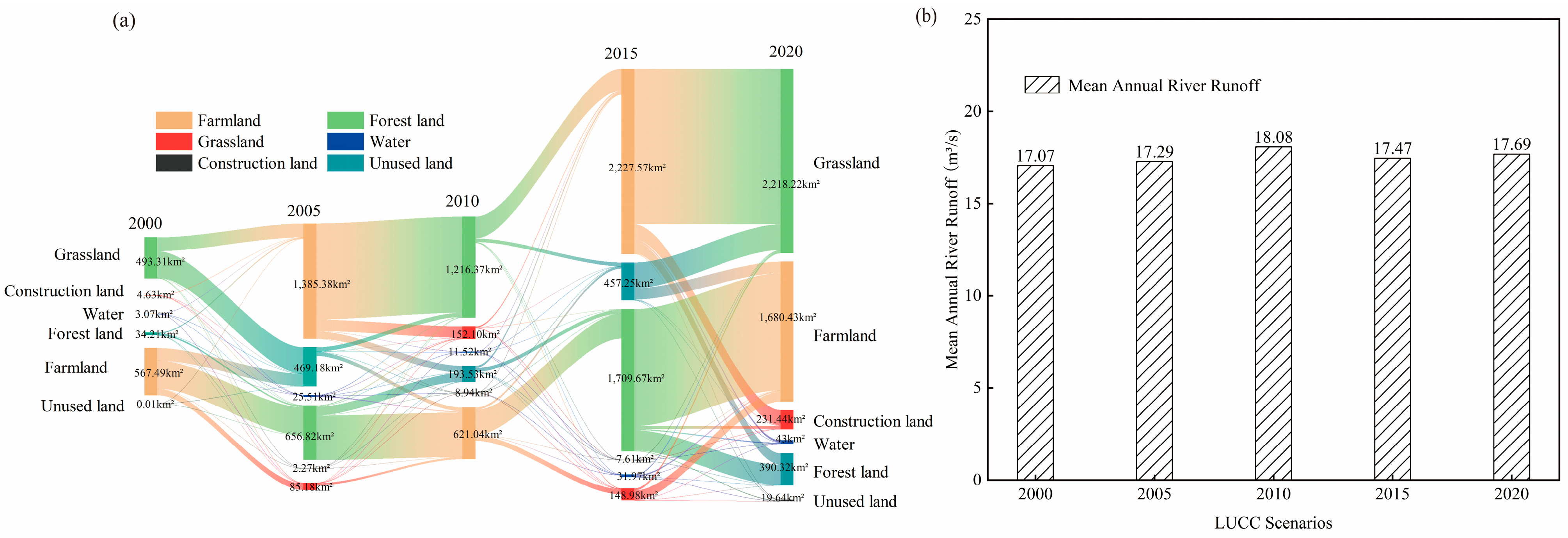
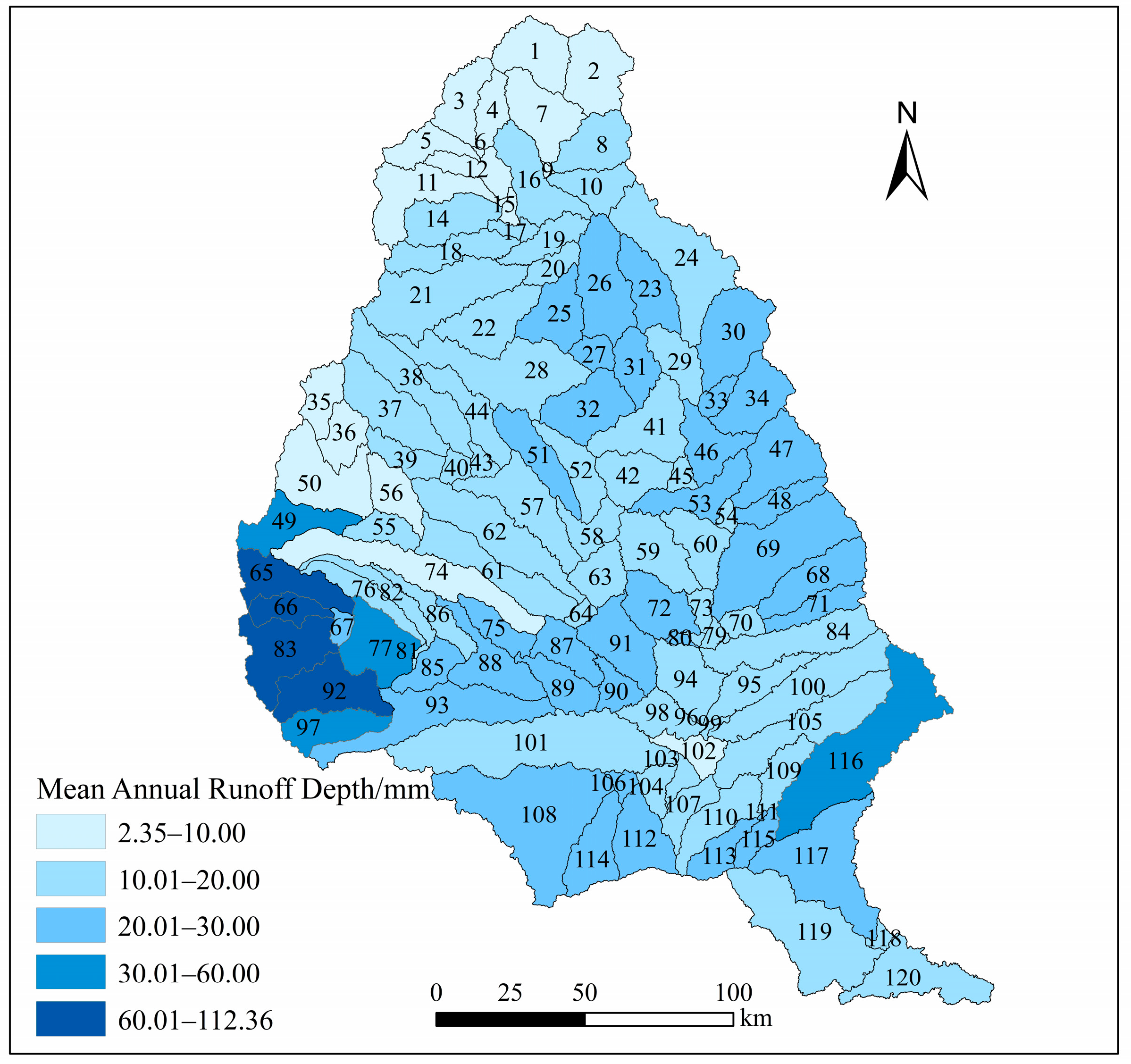
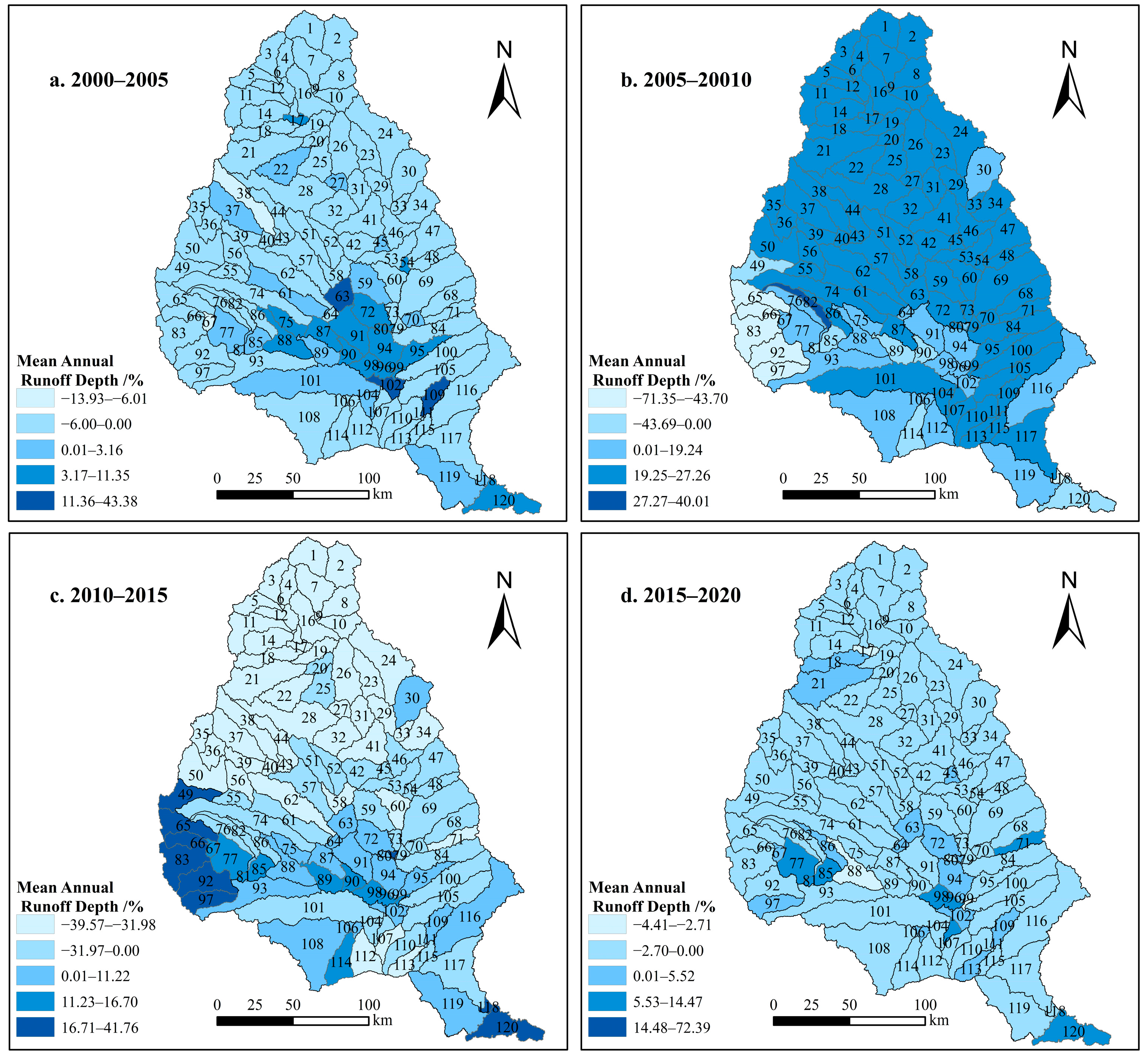
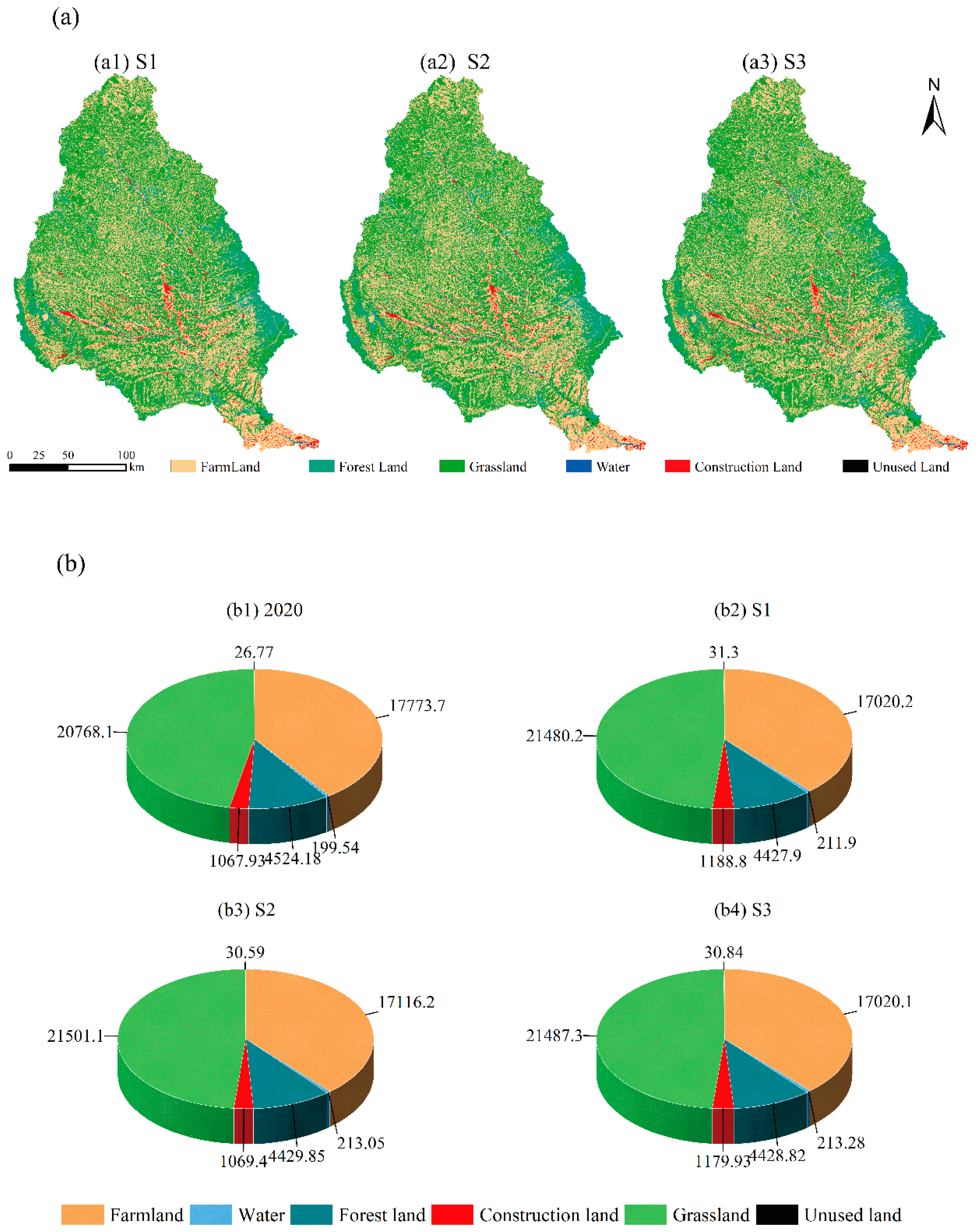

| Model | Data Type | Data | Data Source |
|---|---|---|---|
| SWAT | Digital elevation data | DEM | Geospatial Data Cloud (https://www.gscloud.cn) |
| Meteorological data | CMADS V1.1 Datasets (2008–2016) | The China Meteorological Assimilation Driving Datasets for the SWAT mode (https://cmads.org/) | |
| Hydrological data | Runoff data (2008–2016) | ‘Hydrological Yearbook of the Yellow River Basin’ | |
| Land use data | Land use data (2000, 2005, 2010, 2015, 2020) | Institute of Geographic Sciences and Natural Resources Research, Chinese Academy of Sciences (https://www.resdc.cn) | |
| Soil data | Chinese Soil Dataset (v1.1) Based on World Soil Database (HWSD) | The National Cryosphere Desert Data Center (http://www.ncdc.ac.cn) | |
| PLUS | Land use data | Land use data (2010, 2015, 2020) | Institute of Geographic Sciences and Natural Resources Research, Chinese Academy of Sciences (https://www.resdc.cn) |
| Socio-economic factor | Population (2020) | Resource and Environmental Science and Data Platform (https://www.resdc.cn/) | |
| GDP (2020) | |||
| Accessibility factor | Distance from first level road (2020) | The National Catalogue Service for Geographic Information (https://www.webmap.cn/main.do?method=index (accessed on 24 July 2024)) | |
| Distance from second level road (2020) | |||
| Distance from third level road (2020) | |||
| Distance from county government (2020) | |||
| Distance from water area (2020) | |||
| Natural geographic factor | Soil data | The National Cryosphere Desert Data Center (http://www.ncdc.ac.cn) | |
| Mean annual temperature (2020) | Resource and Environmental Science and Data Platform (https://www.resdc.cn/) | ||
| Mean annual precipitation (2020) | |||
| DEM | Geospatial Data Cloud (https://www.gscloud.cn) | ||
| Slope | Generated from DEM |
| Land Use Type | Farmland | Forest Land | Grassland | Water | Construction Land | Unused Land |
|---|---|---|---|---|---|---|
| S1 | 0.1 | 0.46 | 1 | 0.53 | 0.61 | 0.54 |
| S2 | 0.1 | 0.44 | 1 | 0.52 | 0.59 | 0.51 |
| S3 | 0.1 | 0.32 | 1 | 0.42 | 0.27 | 0.41 |
| Kappa Coefficient | <0.00 | 0.00~0.20 | 0.21~0.40 | 0.41~0.60 | 0.61~0.80 | 0.81~1.00 |
|---|---|---|---|---|---|---|
| Level | Very poor | Slight | Fair | Moderate | Substantial | Almost Perfect |
| Rank | Parameter | Description | Optimal Value | Parameter Range |
|---|---|---|---|---|
| 1 | V__CH_K2.rte | Effective hydraulic conductivity in main channel alluvium | 0.186 | 0~150 |
| 2 | V__CH_N2.rte | Manning’s n value for main channel | 0.214 | 0~0.3 |
| 3 | R__SOL_AWC(..).sol | Soil available water storage capacity | 0.415 | −0.2~1 |
| 4 | V__CN2.mgt | SCS runoff curve number | 55.418 | 35~98 |
| 5 | R__HRU_SLP.hru | Average slope steepness | 0.288 | 0~0.6 |
| 6 | V__TLAPS.sub | Temperature lapse rate | −7.188 | −10~10 |
| 7 | V__GW_DELAY.gw | Groundwater delay time | 390.114 | 0~500 |
| 8 | V__EPCO.hru | Plant uptake compensation factor | 0.891 | 0~1 |
| 9 | R__SOL_ALB(..).sol | Surface reflectance | −0.015 | 0.25~0.25 |
| 10 | V__BIOMIX.mgt | Biological mixing efficiency | 0.663 | 0~1 |
| 11 | R__SOL_Z(..).sol | Soil depth | 0.385 | −0.5~0.5 |
| Land Use Type | 2000–2005 | 2005–2010 | 2010–2015 | 2015–2020 |
|---|---|---|---|---|
| Farmland | −386.1 | −764.3 | −90.3 | −547.1 |
| Forest land | 435.02 | 90.24 | −3.76 | −66.92 |
| Grassland | −131.2 | 559.5 | 35.5 | 508.5 |
| Water | −0.21 | −13.99 | 3.19 | 11.03 |
| Construction land | 80.55 | 119.81 | 52.96 | 82.46 |
| Unused land | 2.25 | 8.75 | 2.34 | 12.03 |
| Land Use Type | Sub-Basin 102 | Sub-Basin 82 | Sub-Basin 92 | Sub-Basin 96 | ||||
|---|---|---|---|---|---|---|---|---|
| 2000 | 2005 | 2005 | 2010 | 2010 | 2015 | 2015 | 2020 | |
| Farmland | 125.61 | 124.14 | 114.19 | 113.85 | 200.84 | 198.99 | 0.30 | 0.24 |
| Forest land | 5.79 | 5.79 | 3.11 | 4.29 | 64.92 | 64.80 | - | - |
| Grassland | 46.66 | 47.04 | 92.76 | 91.88 | 249.29 | 249.49 | 0.04 | 0.02 |
| Water | 6.08 | 6.09 | 0.07 | 0.06 | 0.45 | 0.59 | - | - |
| Construction land | 9.04 | 10.11 | 4.35 | 4.40 | 10.74 | 11.66 | - | 0.08 |
| Unused land | - | - | - | - | 0.16 | 0.87 | - | - |
Disclaimer/Publisher’s Note: The statements, opinions and data contained in all publications are solely those of the individual author(s) and contributor(s) and not of MDPI and/or the editor(s). MDPI and/or the editor(s) disclaim responsibility for any injury to people or property resulting from any ideas, methods, instructions or products referred to in the content. |
© 2025 by the authors. Licensee MDPI, Basel, Switzerland. This article is an open access article distributed under the terms and conditions of the Creative Commons Attribution (CC BY) license (https://creativecommons.org/licenses/by/4.0/).
Share and Cite
Zhang, L.; Li, W.; Chen, Z.; Hu, R.; Yin, Z.; Qin, C.; Li, X. Impacts and Prediction of Land Use/Cover Change on Runoff in the Jinghe River Basin, China. Land 2025, 14, 626. https://doi.org/10.3390/land14030626
Zhang L, Li W, Chen Z, Hu R, Yin Z, Qin C, Li X. Impacts and Prediction of Land Use/Cover Change on Runoff in the Jinghe River Basin, China. Land. 2025; 14(3):626. https://doi.org/10.3390/land14030626
Chicago/Turabian StyleZhang, Ling, Weipeng Li, Zhongsheng Chen, Ruilin Hu, Zhaoqi Yin, Chanrong Qin, and Xueqi Li. 2025. "Impacts and Prediction of Land Use/Cover Change on Runoff in the Jinghe River Basin, China" Land 14, no. 3: 626. https://doi.org/10.3390/land14030626
APA StyleZhang, L., Li, W., Chen, Z., Hu, R., Yin, Z., Qin, C., & Li, X. (2025). Impacts and Prediction of Land Use/Cover Change on Runoff in the Jinghe River Basin, China. Land, 14(3), 626. https://doi.org/10.3390/land14030626







